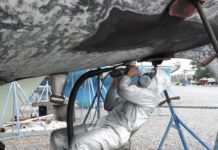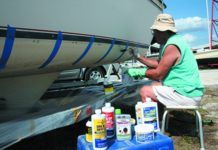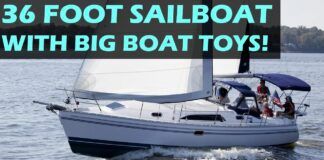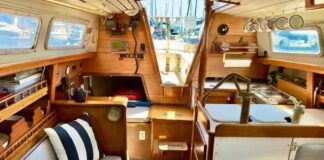Impeller Alternatives
Nearly every sailor I know, and almost every cruising account, tells horrorstories of failed raw water pumps/impellers. Alvah Simons North to theNight, page 77, recounts his replacement of a marine raw water pump with a used twelve-volt circulation pump from a bus heater that had hard plasticblades. He claims the pump was still working fine after about 2-3 years.Has Practical Sailor investigated alternatives to standard rubber impellermarine raw water pumps? If not, would you please consider doing so. Thankyou very much for the superb work you do for us all.
-Will Cain
via e-mail
We havent investigated alternatives to the standard rubber water pump impeller. Alvah Simon may be on to something, but it sounds like a combination of luck and yankee ingenuity (and maybe some prior research) that made the stiff-bladed bus heater impeller work.
Standard rubber impellers, while prone to failure, are at least commonly available everywhere. The trick is to carry spares and be able to change them quickly. For that we recommend SpeedSeal, a housing cover that you can take off and put back quickly. See information at www.speedseal.com.
———-
Charging Misconceptions
Am in need of a new battery for my C&C 35. Your high recommendationfor the GNB Stowaway Power Cycler (October 15, 2000) had me calling the phone number you listed in your article since I could not locate anybody who handles this product. I was surprised to learn from customer service that this new battery needs the support of a smart charger putting out 16.5 volts, apparently to support the 200-minute reserve capacity. I got the impression you did not know this when the articlewas written.
Note in the marine catalogs that no mention of voltage is made.Of course I wouldnt think you would recommend this product if a specialcharger was required to support it. I wonder if a yearly charge at the local auto repair shop would do the trick or am I missing something? Do you plan any updates on this subject? Any comments will be appreciated.
-Kenneth Drewry
via e-mail
We forwarded your questions to the author of our original PS article. Heres the response:
In our opinion, this battery really has no unique requirements, as all batteries make their claims of capacity based on optimal conditions and that means an optimal charger as well as optimal temperatures. They were just more honest about mentioning this fact. The capacity penalty to all modern deep-cycle batteries by using single-stage chargers is about 10-20 percent, depending on the charger used. Even the alternator-powered chargers in boats have this multi-stage technology available as well, and multi-stage chargers are in broad use. (Obviously, there is a performance advantage to using a $200 charger over a $10 charger, or there would be no market for the $200 charger. Weve discussed this fact several times in my articles in PS.)
We tested the Powercycler with $50 single-stage, deep-cycle, 10-amp charger (final voltage 14.6 volts), and the battery came approximately within 10% of its rated capacity, and lasted significantly longer than any equivalent AGM battery tested and charged under the same conditions. Its unrealistic to believe you will obtain the lab condition based ratings in any battery under field conditions. Our recommendation is still with this battery, based on hands-on testing with real world equipment.
We also doubt this battery needs 16.5 volts (irrespective of what you may have been told), as this would exceed the safety margins listed in the batterys specifications and cause it to vent, damaging capacity. It would also be harmful to any electronics plugged in.
———-
Propeller Alternatives
You have done two excellent articles comparing the relative performance characteristics of various types of small boat propellers (Oct 1, 1993 and January 1, 1995). From those articles and the other reading that I have done, I have concluded that the best propeller to replace the existing folding one on my 35-foot sloop is a feathering propeller. The issue I am having trouble resolving is the benefit of a three-blade feathering propeller over a two- blade one. The boat is underpowered by todays standards, therefore I want to maximize the engine performance. My question is whether, for a given horsepower and engine RPM, a three-blade feathering propeller will drive the boat at a higher speed than a two- blade propeller? In adverse conditions (wind, seas) will the three-blade propeller outperform the two-blade?
-James D. Phyfe III
Hong Kong
A three-bladed prop will produce stronger, smoother thrust than a two-bladed prop, which means it will be better at pushing the boat into strong headwinds and chop. Feathering props are a bit less efficient than fixed-blade props at driving the boat forward, mainly because they have less twist built in so that they present less drag when feathered. Even so, a feathering three-blade should be more efficient than a fixed two-blade, and a lot better in reverse.
Boatspeed is another question with more components. If, for example, your boats maximum hull speed is 7 knots and you can reach that speed in flat water with your two-bladed prop, youll probably be able to reach it more easily with the three-bladed prop at the same RPM, and cruise at 6 knots at a lower RPM (depending on how your engine is geared). The three-bladed prop wont have much of an effect on top speed in flat water, although it might muscle the boat ahead a bit faster at the cost of fuel and engine wear. Again, it will be a good deal better at getting you home in a headwind.
You should check with an expert to make sure your engine is geared right for the prop in question. We have a good shop here in Connecticut called the Essex Machine Works. Number: 800/724-0528. You can ask for Bob Claps. Also, read Dave Gerrs definitive Propeller Handbook, available from International Marine Publishers at 800/262-4729.
———-
Metal Boats vs. Lightning
I live in NW Florida.From May to November we have hurricane season, but far more prevalent, and in the aggregate more dangerous, are the daily electrical storms. I have read many articles and talked to numerous lightning experts and survivors. One aspect of lightning protection for metal boats eludes me.If a wood or fiberglass boat needs a grounding plate, does a steel boat also need one? I can bond the aluminum masts and stainless shrouds to the metal hull, but is that (with its several coats of barrier, primer and bottom paint) an adequate ground? Should a steel boat also have a copper grounding plate attached and bonded to the steel hull?If yes, how (considering the high potential for galvanic corrosion)? I understand that lightning protection is not an exact science and avoidance is the best policy, but I do wish to afford myself, my crew and guests the best possible chances in the event of a strike.
-Fred Beauchemin
via e-mail
Because the effects of lightning strikes are so unpredictable, the subject of lightning protection has always provided great debate fodder for sailors.
The American Boat and Yacht Council (ABYC) says of metal-hulled vessels: If there is electrical continuity between metal hulls and masts, or other metallic superstructures of adequate height in accordance with E-4.8, then no further protection against lightning is necessary. (E-4.8 is a section about lightning-protective masts).
For a ground, the ABYC says The boats rudders, struts, external ballast keel, or other external metallic surfaces may provide an external ground plate equivalent.
So, bearing in mind that you already have a comparatively safe boat as far as lightning is concerned, you should focus on the continuity between mast and hull, and on the pathway into the water. In a metal boat you should be able to bond directly to an unpainted section of underwater surface as close to the mast as possible. Even then, some recommend a separate grounding plate or grounding strip with distinct edges mounted outboard and bolted through the hull to an equalization bus inboard. In any case, the area or plate on the outside of the hull should be at least a square foot in size (bigger in fresh water) and should be left exposed.
We consulted with Michael Kasten, a naval architect who specializes in metal boats. Heres what he has to say, for starters:
For the most part, if the mast is properly connected to the hull, it is possible that the boats zinc anodes may provide enough surface area to dissipate the local difference in potential that might otherwise lead to a strike. This requires a spike or brush at the masthead, and a substantial conductor from the mast to the hull.
As for the situation of an actual strike, the main adventure is to prevent side flashes which may decide to pass through big equipment, such as engine/shaft/prop. The typical strategy is to attempt to provide a preferred path which has as its purpose to instead direct the energy of the strike toward a region of exposed metal below the water near the base of the mast, for which the zincs may or may not be adequate.
Kasten has a booklet called Corrosion, Zincs & Bonding that details several possibilities for metal-boat owners. It can be downloaded from his website (PDF format, 350K). The web address is: www.kastenmarine.com. His e-mail address is: [email protected].







































